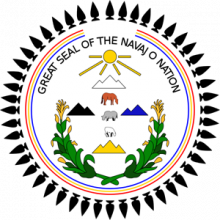Article
In 1952 the Navajo Tribal Council officially adopted the Great Seal of the Navajo Tribe, which was designed by John Claw Jr., an Arizona Navajo artist. The fifty arrowheads encircling the seal represent the tribe's protection within the fifty states. The lines of the inner circle represent a rainbow, as well as the sovereignty of the Navajo Nation. The opening at the top stands for the East, the place of the rising sun. Below the opening the sun shines on the four mountains sacred to the tribe: Blanca Peak in eastern Colorado, with white representing White Shell Woman in the East; Mount Taylor in New Mexico, with blue representing Turquoise Woman in the South; San Francisco Peaks in Arizona, with yellow representing Abalone Woman in the West; and Hesperus Mountain in western Colorado, with black representing Jet Woman in the North. In the center are a horse, a cow, and a sheep, the traditional livestock of the Navajo. The two corn plant at the bottom are symbolic of the sustainer of Navajo life. The yellow pollen at the tips of the corn plants is used in many sacred Navajo ceremonies.
"Great Seal of the Navajo Nation," uploaded by Bobby C. Hawkins is licensed under CC BY-SA.
Manuscripts
References
Linford, Laurence, D.
2000 Navajo Places: History, Legend, Landscape. Salt Lake City: University of Utah Press.
Office of Navajo Government Development
1994 Navajo Nation Government. Window Rock, AZ: Office of Navajo Government Development.

